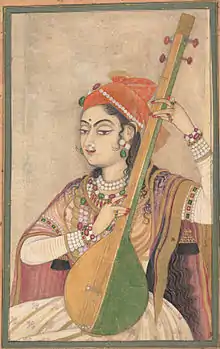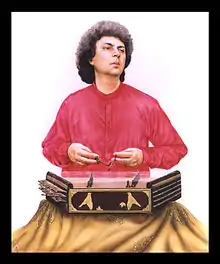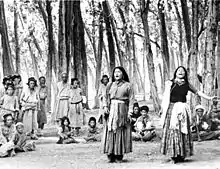Music of Jammu and Kashmir and Ladakh
Music of Jammu and Kashmir and Ladakh reflects a rich musical heritage and cultural legacy of the union territories of Jammu and Kashmir and Ladakh. Two different regions of Jammu and Kashmir, consists upper Jammu Division and Kashmir Valley's music is closer to Central Asian music[1] while music from Jammu region is similar to that of North India and Ladakhi music is similar to the music of Tibet.[2]
| Music of India | |
|---|---|
 A lady playing the Tanpura, c. 1735 (Rajasthan) | |
| Genres | |
Traditional
Modern | |
| Media and performance | |
| Music awards | |
| Music festivals | |
| Music media | |
| Nationalistic and patriotic songs | |
| National anthem | Jana Gana Mana |
| Regional music | |
| |
Jammu and Kashmir
Chakri
Chakri is one of the most popular types of traditional music played in Jammu & Kashmir. Chakri is a responsorial song form with instrumental parts, and it is played with instruments like the harmonium, the rubab, the sarangi, the nout, the geger, the tumbaknaer and the chimta. It is performed in folk and religious spheres, by the Muslim and Hindu kashmiris.[3] Chakri was also used to tell stories like fairy tales or famous love stories such as Yousuf-Zulaikha, Laila-Majnun, etc. Chakri ends with the rouf, though rouf is a dance form but few ending notes of Chakri which are played differently and on fast notes is also called Rouf.[4] It is a very important part of the Henna Night (Ma'enzi raat) during weddings.
Henzae
Henzae is a traditional and ancient form of singing which is practiced by Kashmiri Pandits at their festivals. It appears to have archaic features that suggest it is the oldest form of Kashmiri folk singing.[5]
Rouf or Wanwun
Rouf is a traditional dance form usually performed by women on certain important occasions like marriage and other functions and also in cultural activities.[6]
Ladishah
Ladishah is one of the most important parts of the Kashmiri music tradition. Ladishah is a sarcastic form of singing. The songs are sung resonating to the present social and political conditions and are utterly humorous. The singers move from village to village performing generally during the harvesting period. The songs are composed on the spot on issues relating to that village, be it cultural, social or political. The songs reflect the truth and that sometimes makes the song a bit hard to digest, but they are totally entertaining.[7][8][9]
Sufiana Kalam (Kashmiri classical)
Sufiana Kalam is the classical music of Kashmir, which uses its own ragas (known as maqam), and is accompanied by a hundred-stringed instrument called the santoor, along with the Kashmiri saz, the setar, the wasool and the dokra. The dance based on the sofiyiana kalam is the hafiz nagma.[4]

Hindustani classical
Music and musical instruments find mention in the earliest texts like the Nilmatapurana and Rajatarangini by Kalhana. The very fact that it was a Kashmiri, Abhinavagupta (the great philosopher), who wrote a commentary called Abhinavabharati on Bharata's Natyashatra shows how much importance was given to music in the ancient times. A favorite traditional instrument is the santoor (Shat-tantri-veena), a hundred string percussion instrument which is played by the goddess Sharada (the goddess of learning and art in ancient Kashmir).
Notable santoor players from Jammu and Kashmir include Shivkumar Sharma, from Jammu, and Bhajan Sopori from the Kashmir Valley.
Jammu region
Music in Jammu is mainly in Dogri language,[10][11][12][13][14] Gujari language, Pahari language and Punjabi language. Traditional Dogri folk song is known as Bhakh.[15]
Ladakh
Ladakh is a Union territory of India and was formerly part of Jammu and Kashmir.[16]
Dance

One of the main features of a Ladakh marriage is the recitation of lengthy narratives by singers in unusual costumes. Popular dances in Ladakh include the Khatok Chenmo (only when headed by an aristocratic family member), Shondol,[17] Kompa Tsum-tsak (meaning three successive steps), Jabro (dance steps from western Ladakh), Chaams: (sacred dance by lamas), Chabs-Skyan Tses (dance carrying a pot), Raldi Tses (swordsmanship dance) and Alley Yaato (Zanskari Dance and Song Sequence).
Music
Traditional music includes the instruments Daman, Surna and Piwang (Shehnai and Drum). The music of Ladakhi Buddhist monastic festivals, like Tibetan music, often involves religious chanting in Tibetan or Sanskrit as an integral part of the religion. These chants are complex, often recitations of sacred texts or in celebration of various festivals. Yang chanting, performed without metrical timing, is accompanied by resonant drums and low, sustained syllables. Religious mask dances are an important part of Ladakh's cultural life. Hemis monastery, a leading centre of the Drukpa tradition of Buddhism, holds an annual masked dance festival, as do all major Ladakhi monasteries. The dances typically narrate a story of the fight between good and evil, ending with the eventual victory of the former.[18]
Dress
.jpg.webp)
Weaving is an important part of traditional life in eastern Ladakh. Both women and men weave, on different looms.[19] Typical costumes include gonchas of velvet, elaborately embroidered waistcoats and boots and hats. The Ladakh Festival is held every year from 1 to 15 September. Performers adorned with gold and silver ornaments and turquoise headgear throng the streets. Monks wear colourful masks and dance to the rhythm of cymbals, flutes and trumpets. The yak, lion and Tashispa dances depict the many legends and fables of Ladakh. Buddhist monasteries sporting prayer flags, display of thankas, archery competitions, a mock marriage and horse-polo are the some highlights of this festival.[20]
See also
References
- "Common Cultural Links Between Kashmir & Central Asia". Kashmir Observer. Archived from the original on 24 November 2010.
- http://www.visitlehladakh.com/Culture.html%5B%5D
- The Garland Encyclopedia of World Music: South Asia : the Indian subcontinent.
- Mohammad Saleem Mir (Salsoftin Networks). "Kashmir Music Download, Free Kashmir Music, Kashmir mp3 Songs, Kashmiri Songs Free Download, Download Mobile Ringtones, Singtones in kashmir, Latest Kashmir Music Download, Kashmir Songs, Santoor, Chakri, Sufiana".
- P.N. Pushp, Henzae: A Folk Genre Viewed Afresh
- "Folk Dances of Kashmir". Archived from the original on 13 May 2012.
- "Famous Kashmiri Music And Dance of Jammu And Kashmir".
- "Archived copy". Archived from the original on 21 February 2001. Retrieved 30 May 2009.CS1 maint: archived copy as title (link)
- "The Traditional Music of Kashmir by Dr. Sunita Dhar".
- Limited, InLinks Communication Private. "The profound richness and vitality of Dogra culture". Jammu Links News. Retrieved 22 July 2020.
- Sengupta, Trisha (8 May 2020). "Kadun Jaana Tu Coroneyaa: Siblings sing in Dogri on coronavirus, people love it". Hindustan Times. Retrieved 22 July 2020.
- "Remembering a stalwart of Dogri". Daily Excelsior. 11 July 2020. Retrieved 22 July 2020.
- Tagat, Anurag (17 July 2020). "Lockdown music videos go mobile". The Hindu. Retrieved 22 July 2020.
- "Jammu Origin Artist Bhau Brings a Refreshing Twist to Dogri on 'Kelli?' -". Rolling Stone. 18 May 2020. Retrieved 22 July 2020.
- "DSS celebrates 'Dogri Manyata Diwas'". Daily Excelsior. 11 July 2020. Retrieved 22 July 2020.
- Dubey, Navneet (5 August 2019). "Ladakhis ecstatic after government proposes Union Territory status". Hindustan Times. Retrieved 7 September 2020.
- "Ladakhi Shondol dance makes it to Guinness book of records". The Tribune. 22 September 2019. Retrieved 7 September 2020.
- "Masks: Reflections of Culture and Religion". Dolls of India. Archived from the original on 10 July 2011. Retrieved 21 August 2006.
- "Living Fabric: Weaving Among the Nomads of Ladakh Himalaya". Archived from the original on 29 June 2011. Retrieved 21 August 2006.
- Jina, Prem Singh (1994). Tourism in Ladakh Himalaya. Indus Publishing. ISBN 81-7387-004-7.